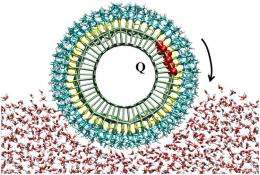December 18, 2009 feature
Light-Driven Nanorod Could Roll on Water

(PhysOrg.com) -- In a recent study, researchers have examined the possibility of rolling a nanorod on the surface of water. On the macroscale, perhaps the closest analogy might be the sport of logrolling, in which two competitors try to balance on a log the longest while the log rolls on water. However, while the macro log rolls due to the competitors walking on it, the nanorod would roll by becoming electrically polarized by a beam of light.
The researchers, Lela Vuković and Petr Král from the University of Illinois at Chicago, have developed a model of such a nanorod rolling on water. Using molecular dynamics simulations, the scientists showed how nanorods with diameters of 3-10 nanometers could roll on water with translational velocities of up to 5 nanometers per nanosecond. Their study is published in a recent issue of Physical Review Letters.
“Moving nanoobjects on fluids might be simpler than moving macroscopic objects because of the irrelevance of gravity,” Vuković told PhysOrg.com. “We are the first group who investigated seriously the idea of rolling nanorods on air/liquid interfaces. Our simulations of rolling nanorods confirm that one can in principle use the same or similar principles that Nature uses, where water spiders and even some lizards can walk on fluids.”
In order to roll the nanorod on water, the scientists explained how to charge the nanorod’s surface with a light beam tilted with respect to the surface of the water. The light excites the nanorod’s chromophores, which are the parts of molecules that absorb photons. Then the nanotube’s polarized chromophores become attracted to the water’s highly polar molecules, causing the nanorod to roll. By matching the time the light beam reaches the chromophores with the rotation speed of the nanorods, the researchers theoretically showed they should be able to keep the nanorod rolling at a steady pace.
As the scientists explained, the nanorod must couple well enough to the water surface to be propelled with minimal slipping, but not too much so that it becomes deeply buried and has to push a lot of water to move. To determine how the nanorod might roll most efficiently, the scientists analyzed the chemistry at the nanorod-water interface.
In their model, the researchers also determined that the nanorod should be able to pull objects attached to it as it rolls on the water. This ability could make the system a possible candidate for transporting nanoscale cargo at the cellular level, which could be useful in biological applications, such as manipulation of large proteins.
“Potentially, we can imagine an array of nanoobjects that can be synchronously controlled on liquid surfaces,” Král said. “These objects can have a variety of applications in sensing, or material preparation. We can also use the nanorods to autonomously drag cargo on the fluid surfaces. They can prepare tiny nets like fishing boats for novel types of applications. We will probably know more about the real capabilities of these systems after our first experiments will be done in the near future.”
More information: Lela Vuković and Petr Král. "Coulombically Driven Rolling of Nanorods on Water." Physical Review Letters 103, 246103 (2009).
Copyright 2009 PhysOrg.com.
All rights reserved. This material may not be published, broadcast, rewritten or redistributed in whole or part without the express written permission of PhysOrg.com.

















